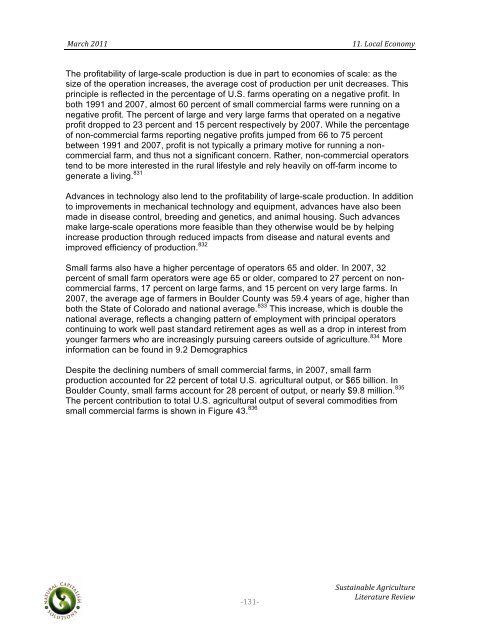Sustainable Agriculture Literature Review - Boulder County
Sustainable Agriculture Literature Review - Boulder County
Sustainable Agriculture Literature Review - Boulder County
Create successful ePaper yourself
Turn your PDF publications into a flip-book with our unique Google optimized e-Paper software.
! !!<br />
"#$%&!'())!! !!!!!!!!!!!!!!!!!!!!!!!!!!!!!!!!!!!!!!!!!!!!!!!!!!!!!!!!!!!!!!))+!9-%#/!H%-5-BF!<br />
The profitability of large-scale production is due in part to economies of scale: as the<br />
size of the operation increases, the average cost of production per unit decreases. This<br />
principle is reflected in the percentage of U.S. farms operating on a negative profit. In<br />
both 1991 and 2007, almost 60 percent of small commercial farms were running on a<br />
negative profit. The percent of large and very large farms that operated on a negative<br />
profit dropped to 23 percent and 15 percent respectively by 2007. While the percentage<br />
of non-commercial farms reporting negative profits jumped from 66 to 75 percent<br />
between 1991 and 2007, profit is not typically a primary motive for running a noncommercial<br />
farm, and thus not a significant concern. Rather, non-commercial operators<br />
tend to be more interested in the rural lifestyle and rely heavily on off-farm income to<br />
generate a living. 831<br />
Advances in technology also lend to the profitability of large-scale production. In addition<br />
to improvements in mechanical technology and equipment, advances have also been<br />
made in disease control, breeding and genetics, and animal housing. Such advances<br />
make large-scale operations more feasible than they otherwise would be by helping<br />
increase production through reduced impacts from disease and natural events and<br />
improved efficiency of production. 832<br />
Small farms also have a higher percentage of operators 65 and older. In 2007, 32<br />
percent of small farm operators were age 65 or older, compared to 27 percent on noncommercial<br />
farms, 17 percent on large farms, and 15 percent on very large farms. In<br />
2007, the average age of farmers in <strong>Boulder</strong> <strong>County</strong> was 59.4 years of age, higher than<br />
both the State of Colorado and national average. 833 This increase, which is double the<br />
national average, reflects a changing pattern of employment with principal operators<br />
continuing to work well past standard retirement ages as well as a drop in interest from<br />
younger farmers who are increasingly pursuing careers outside of agriculture. 834 More<br />
information can be found in 9.2 Demographics<br />
Despite the declining numbers of small commercial farms, in 2007, small farm<br />
production accounted for 22 percent of total U.S. agricultural output, or $65 billion. In<br />
<strong>Boulder</strong> <strong>County</strong>, small farms account for 28 percent of output, or nearly $9.8 million. 835<br />
The percent contribution to total U.S. agricultural output of several commodities from<br />
small commercial farms is shown in Figure 43. 836<br />
!<br />
"')'"<br />
!,342#.5#6/1!78$.%3/23$1!<br />
9.21$#23$1!:1;.1
















